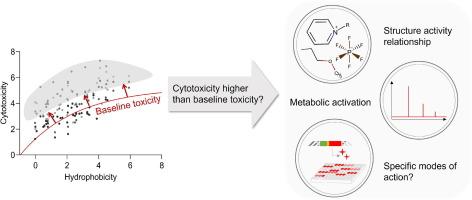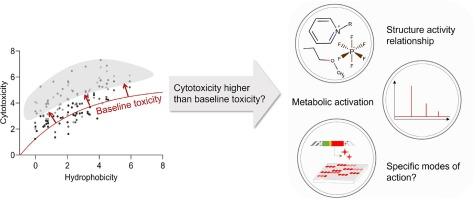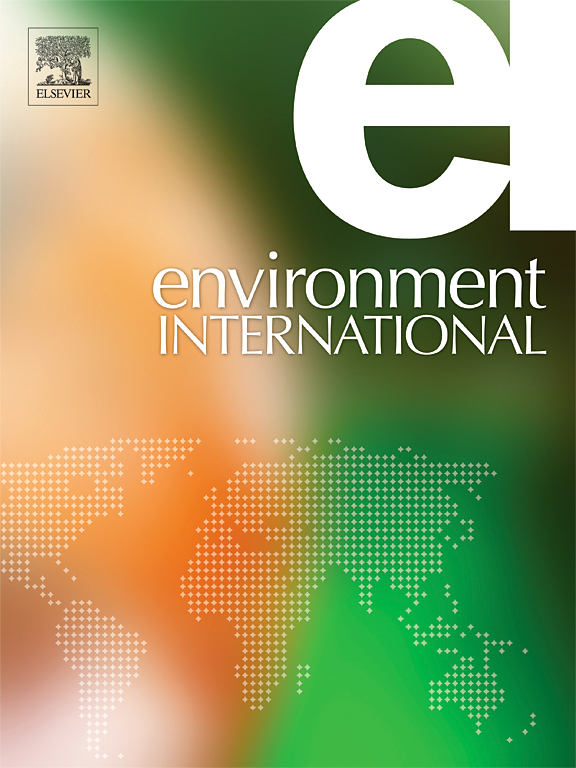The mode of toxic action of ionic liquids: Narrowing down possibilities using high-throughput, in vitro cell-based bioassays
IF 10.3
1区 环境科学与生态学
Q1 ENVIRONMENTAL SCIENCES
引用次数: 0
Abstract
Growing concerns about the environmental impact of ionic liquids (ILs) have spurred research into their (eco)toxic effects, but studies on their mode of toxic action (MOA) still remain limited. However, understanding the MOA and identifying structural features responsible for enhanced toxicity is crucial for characterising the hazard and designing safer alternatives. Therefore, 45 ILs, with systematically varied chemical structures, were tested for cytotoxicity and two specific endpoints in reporter gene assays targeting the Nrf2-ARE mediated oxidative stress response (AREc32) and aryl hydrocarbon receptor activation (AhR-CALUX). While none of the ILs activated the reporter genes, cytotoxicity was high and markedly different between cell lines. Seven and 25 ILs proved more cytotoxic than predicted by baseline toxicity model in the AREc32 and the AhR-CALUX assays, respectively. The length of the side chain and headgroup structures of ILs altered the MOA of ILs. Cellular metabolism of the ILs, investigated by LC-MS/MS, showed side-chain oxidation of the long-chain quaternary ammonium compounds in AhR-CALUX cells and, to a lower extent, in AREc32 cells, however, this transformation could not explain the high cytotoxicity. Effect data for 72 ILs for ten endpoints retrieved from the Tox21 database identified the inhibition of aromatase activity and of mitochondrial membrane potential as potential MOAs. However, in vitro fluorimetric assays for these endpoints demonstrated that effects were activated in a non-specific manner, probably through cytotoxicity. Although many of the ILs tested induced cytotoxicity at concentrations lower than baseline toxicity, the specific MOAs responsible could not be identified. Alternatively, we suggest that the descriptors currently used may fail to define the affinity of ILs for cells. Testing of the affinity of ILs for a diverse range of biomolecules is needed to accurately describe their interactions with cells.


离子液体的毒性作用模式:利用高通量体外细胞生物测定缩小可能性范围
人们越来越关注离子液体(ILs)对环境的影响,这推动了对其生态毒性效应的研究,但对其毒性作用模式(MOA)的研究仍然有限。然而,了解毒性作用模式并确定导致毒性增强的结构特征,对于确定危害特征和设计更安全的替代品至关重要。因此,我们对 45 种化学结构各不相同的 IL 进行了细胞毒性测试,并在报告基因试验中对 Nrf2-ARE介导的氧化应激反应(AREc32)和芳基烃受体激活(AhR-CALUX)这两个特定终点进行了测试。虽然没有一种 IL 能激活报告基因,但细胞毒性却很高,而且不同细胞系的细胞毒性明显不同。在 AREc32 和 AhR-CALUX 试验中,分别有 7 种和 25 种 IL 的细胞毒性高于基准毒性模型的预测值。ILs侧链和头基结构的长度改变了ILs的MOA。通过 LC-MS/MS 对 ILs 的细胞代谢进行了研究,结果显示长链季铵盐化合物在 AhR-CALUX 细胞中发生了侧链氧化,在 AREc32 细胞中的氧化程度较低,但这种转变并不能解释高细胞毒性的原因。从 Tox21 数据库中检索到的 72 种惰性类化合物对 10 个终点的影响数据表明,抑制芳香化酶活性和线粒体膜电位是潜在的 MOA。不过,针对这些终点的体外荧光测定表明,这些效应是以非特异性方式激活的,可能是通过细胞毒性激活的。虽然测试的许多 IL 在浓度低于基线毒性时会诱导细胞毒性,但无法确定具体的 MOAs。另外,我们认为目前使用的描述符可能无法确定 IL 对细胞的亲和力。要准确描述 IL 与细胞的相互作用,就需要测试 IL 对各种生物大分子的亲和力。
本文章由计算机程序翻译,如有差异,请以英文原文为准。
求助全文
约1分钟内获得全文
求助全文
来源期刊

Environment International
环境科学-环境科学
CiteScore
21.90
自引率
3.40%
发文量
734
审稿时长
2.8 months
期刊介绍:
Environmental Health publishes manuscripts focusing on critical aspects of environmental and occupational medicine, including studies in toxicology and epidemiology, to illuminate the human health implications of exposure to environmental hazards. The journal adopts an open-access model and practices open peer review.
It caters to scientists and practitioners across all environmental science domains, directly or indirectly impacting human health and well-being. With a commitment to enhancing the prevention of environmentally-related health risks, Environmental Health serves as a public health journal for the community and scientists engaged in matters of public health significance concerning the environment.
 求助内容:
求助内容: 应助结果提醒方式:
应助结果提醒方式:


